Humming Blog |
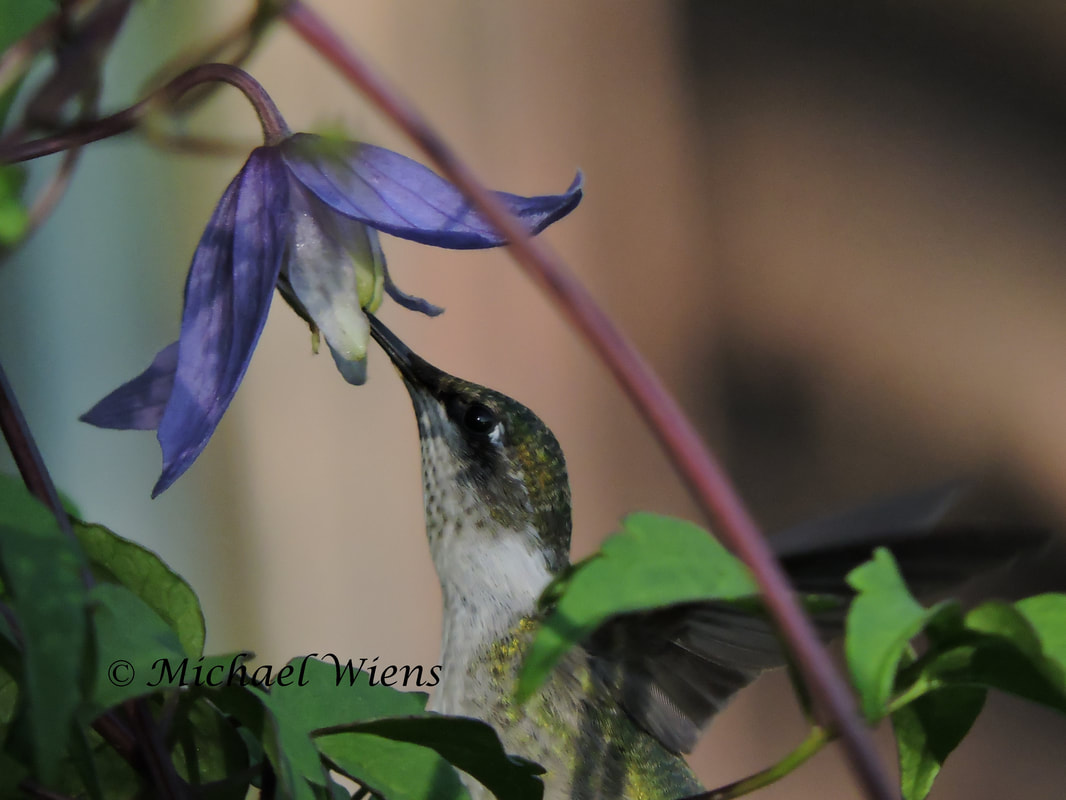 This morning I woke up to -21 C. I don't know if I've ever experienced temperatures this cold this time of year. I am fully expecting later than normal arrival times for migrating birds as 16 inches of snow still sit on my lawn. We are 15 degrees Celsius below average(that's a whopping 30 F). While I've always seen hummingbirds appear in my garden within a 7 day period throughout the years, some other regions like eastern Canada have a broader range to go by. I fully anticipate later than normal sightings in Eastern Canada and most regions of N.E. United States. With temperatures colder than normal across most of North America, this will ultimately affect all migrating species of hummingbirds. What effect it'll have on populations is yet to be seen, but as usual, it all gets sorted in the end. Vines of Bluebird Clematis wove in and out of all the lilac colored blossoms, and hopping from one bloom to another made it difficult to capture the perfect moment. I've mentioned in a past post to anticipate their movement and focus on a flower in the direction they're heading, and that's just what I did. I pointed and focused, and within seconds he appeared right in frame. I snapped out a burst and managed a couple decent pictures in amongst the vines. Juvenile Male Ruby-throat hummingbird. N.E. of Edmonton, Alberta, Canada. August 2017
0 Comments
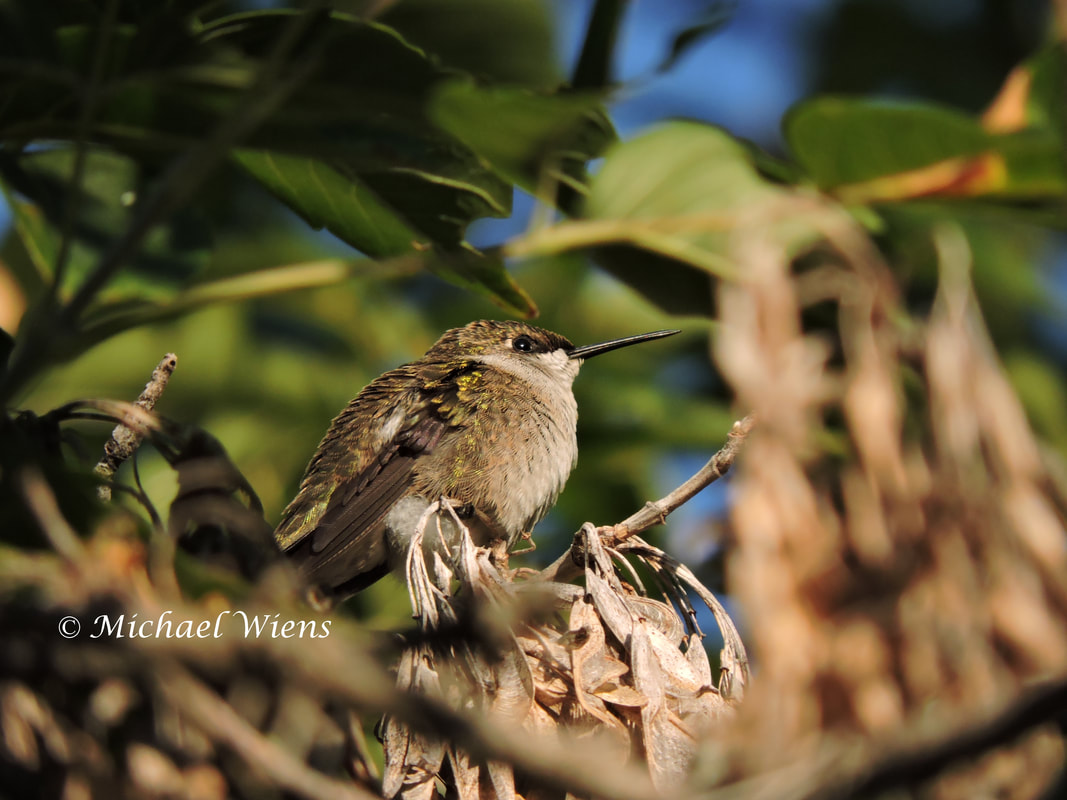 It was late season and the days were considerably shorter, while the mornings were crisp and the songbirds had gone silent. It was the time of year I dreaded. All the summer birds were already in migration mode and the last few hummingbirds remained. This young Ruby-throat was cold and contemplating life. A 2000 mile journey was hours away, but he sat on an open branch and soaked up every bit of morning sunrise he could. After a very cool night, the heat from the sunrise was desperately needed for those stiff little muscles, his and mine. The final hummingbirds were leaving in late summer, and I knew what lay ahead. The cold long winter is now still lingering here in the north, but Spring time is our great reward for enduring the difficulty. Snow is melting a bit each day, and a few song birds are showing signs that Spring is nearly upon us. The Northern migration is in full swing with many species, and over the next couple months the landscape will be changed dramatically. There is no greater time of year than now. Renewed life is everywhere from soil to sky. It's the time of year to savor every sight, sound and smell, and not waste a single moment. Young male Ruby-throat hummingbird, N.E. of Edmonton, Alberta, Canada. Late August 2017 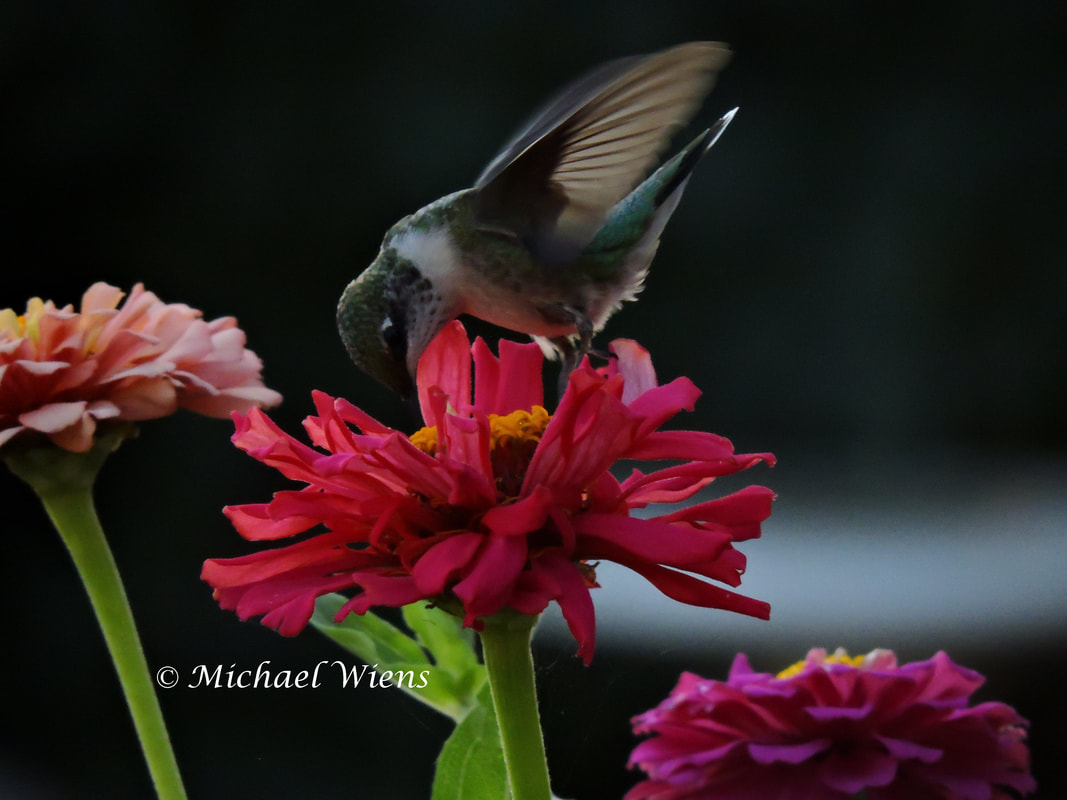 As every minute passed, the sun dipped lower towards the horizon, and my photo ops also passed. But just before my time ran out, a young Ruby fumbled around in the Zinnias. I continuously adjusted the camera according to the diminished light and managed a few final captures. Young hummingbirds always find Zinnias a pretty good source of food, and also like to perch on the petals of the flower. It's kind of like they're sitting on their dinner plate while they eat. Those large colorful pom-poms bloom in the most brilliant colors, and even though they don't drip with nectar, young hummingbirds manage to dig around in those pollen filled buttons, and peak and poke under the layers of petals to find something of interest. Zinnias are a 3 out of 5 rated flower for hummingbirds(which is quite good), but dependent on the bird, some would probably rate them even higher. Because of their height, flower size and food content, I would never plant a hummingbird garden without them. Young hummingbirds are especially attracted to them. If you're able to purchase Zinnias, they'll be worth your while, and if you have 1 or 2 green thumbs, plant a bunch of them. You won't regret it. Juvenile Male Ruby-throat hummingbird. N.E. of Edmonton, Alberta, Canada. August 2017. 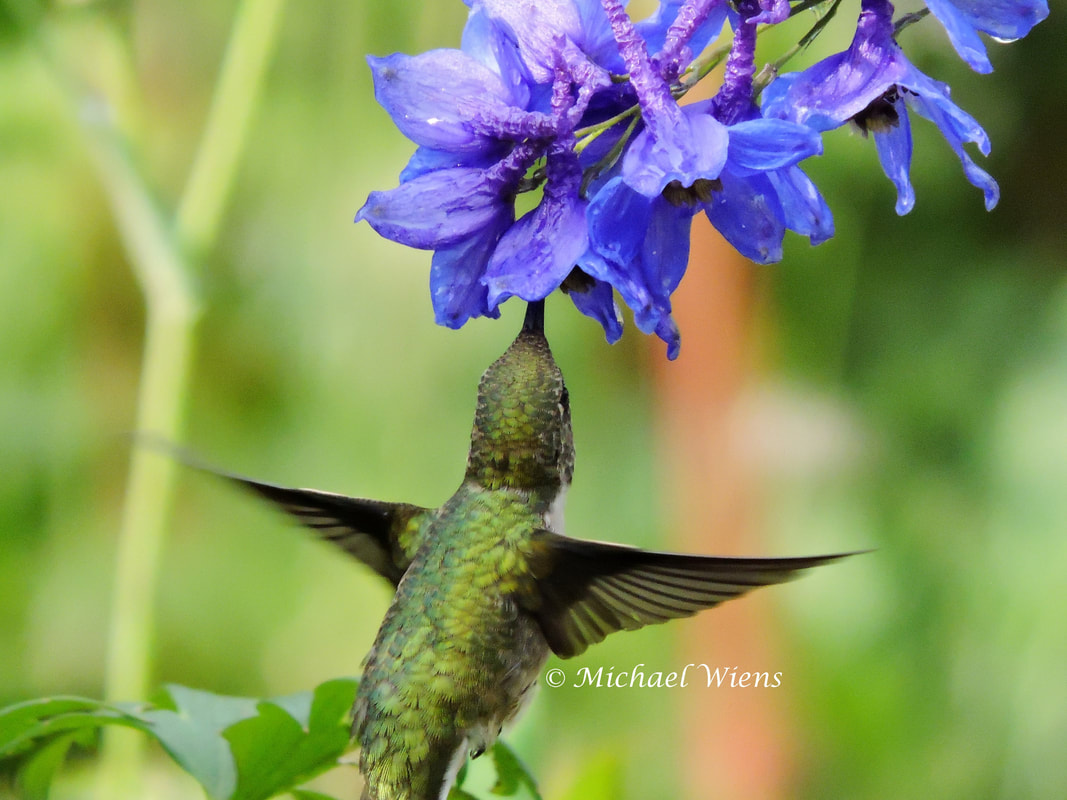 The technique and muscle strength to be able to hover in one spot, to fly in all directions, and to feed in the most awkward positions, requires abilities beyond understanding. Besides the feeding and fighting that we see of these birds, they travel thousands of miles every year. That means those tiny but powerful wings make hundreds of millions of strokes in their lifetime. That kind of craftsmanship is impossible to replicate by human hands. The intricate and colorful little feathers are woven together to create a shape so adorable and beautiful at the same time. The organs operate at speeds unthinkable. Their abilities, memories, personalities all have a special added touch to make each one unique. And on top of that, no one pushes them around. Despite their size, a bit of humor had to be used to give them an attitude more fierce than a wolverine. What's more spectacular is that over 300 more species, painted in magnificent colors, are spread out over just the Americas. Here is an image of a young Ruby-throat hovering under a drooped over Delphinium from the heavy rains. All the blooms on the underside of this flower stalk were still undiluted nectar. Juvenile Ruby-throat hummingbird. N.E. of Edmonton, Alberta, Canada. 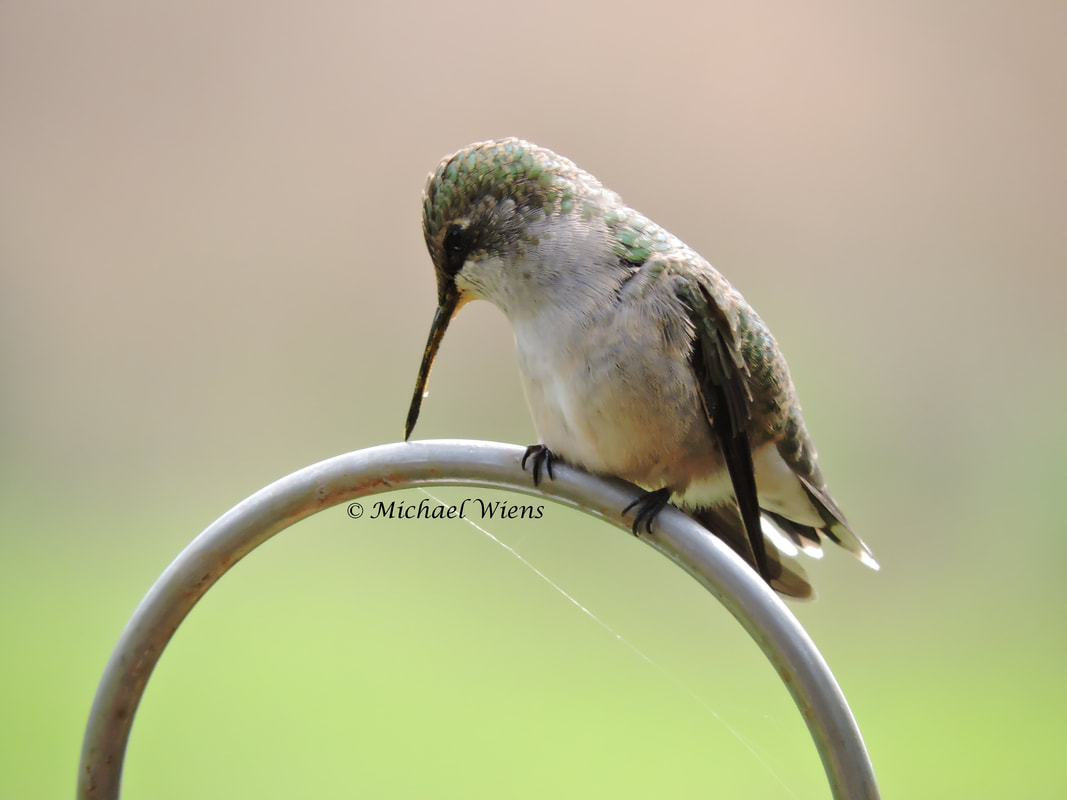 Right from the nest, young birds compete with each other for the food that the mother brings. They develop that competitive behavior right out of the egg. It's about survival. If you find a food source, protect it. Watching and hearing their squeaky fights can appear like the most adorable thing, but in reality they will fight fiercely for what they like, sometimes resulting in serious injury. This young male Ruby-throat hummingbird initially protected the Nasturtium flowers that were laid out below him, but soon discovered the feeder hanging from the little shepherd's hook he's sitting on. He was proud of his find, and discovered that he didn't have to work that hard to get an enormous amount of food from it. This became his guard perch. Any hummingbird that passed by or even thought about testing out his little territory got a squeak or two and a beak wag. N.E. of Edmonton, Alberta, Canada. August 2017 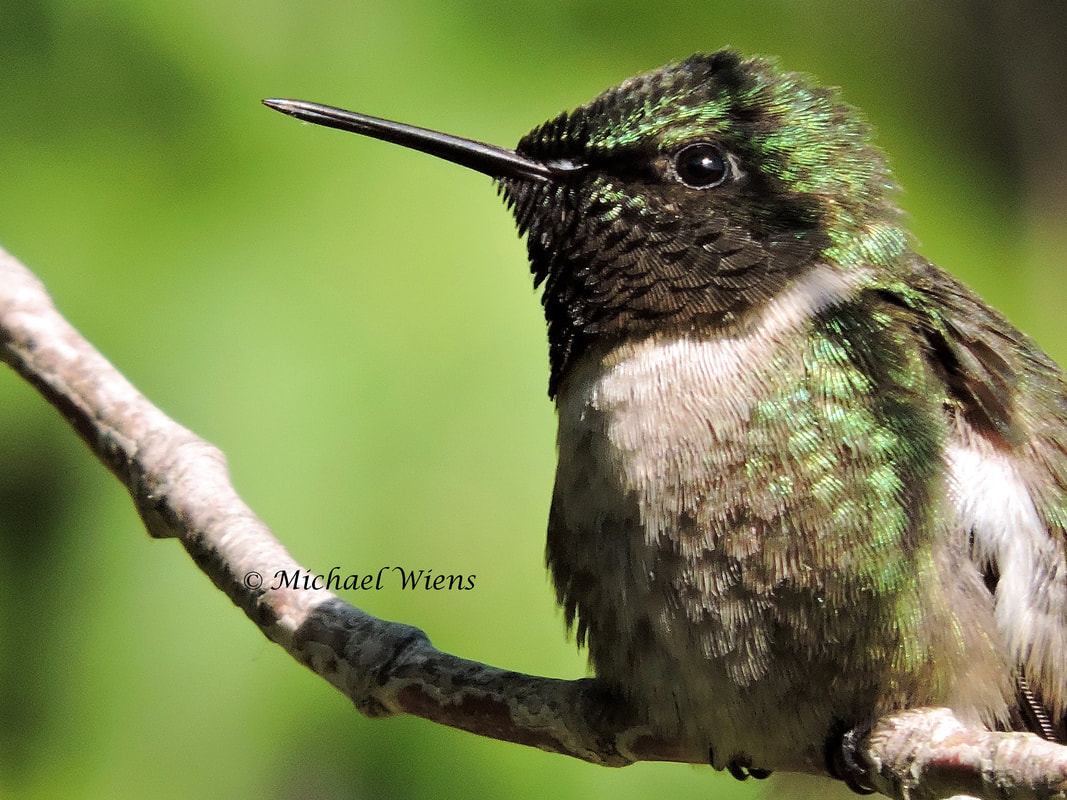 It was yesterday morning that I was alerted to the sound of Canada Geese as a dozen of them made their first appearance of the year over my place. Canada geese are my Spring harbinger, and it just gets better from there. We had another snowfall, but it started to melt by afternoon, and the smells of Spring were evident. Melting snow, cheerful songbirds and warming temperatures are teasing me to what's to come over the next couple months. As many gardens across the Southern U.S. are currently seeing hummingbirds, I will anxiously wait for another 2 months to see mine. It's been an unusually cold Spring so I fully anticipate later than normal hummingbirds in many regions of Canada as well as Northeastern U.S.. Either way, I love the build up to Spring. There is nothing about Spring that brings disappointment. Gardens liven up with new songbirds, perennials prove their hardiness after a bitterly cold winter, and shortly after that many little visitors make Spring even more special. While I'm excited by the arrival of the Ruby-throat and the Rufous hummingbirds across many regions in the south, I will continue to plan for the arrival of this "Jewel of the North". Ziggy, my summer resident Male Ruby-throat hummingbird from May 2017. N.E. of Edmonton, Alberta, Canada. 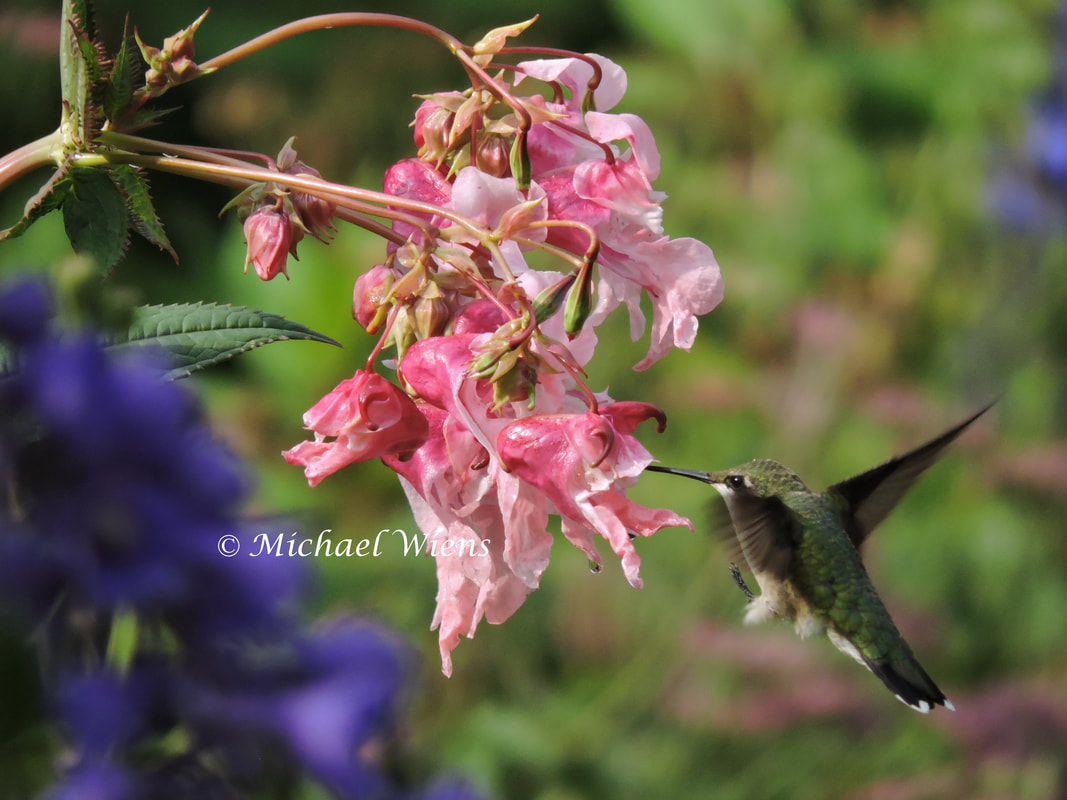 Young birds tend to use their feet a lot more in the early days until they develop cordination in their wings and learn how to control speed and direction. They extend their feet on landings and to assist in feeding. Once they learn to control their start and stop better, they'll rely on the pinpoint accuracy that the wings will provide. Eventually the legs become less important in their movement to the point they rarely need to be extended, except for emergency and fierce battles. This young bird was coming in for a landing, being fully prepared to grasp hold of the lower petal of the flower. It's sharp little talons would pierce through the petals and provide enough traction for it to gain hold and feed for a few seconds in each flower. Once they mature, they will tuck in those feet to be rarely shown, and start to choose flowers that require a little less monkey work to get the nectar. Juvenile Ruby-throat hummingbird. N.E. of Edmonton, Alberta, Canada. August 2017 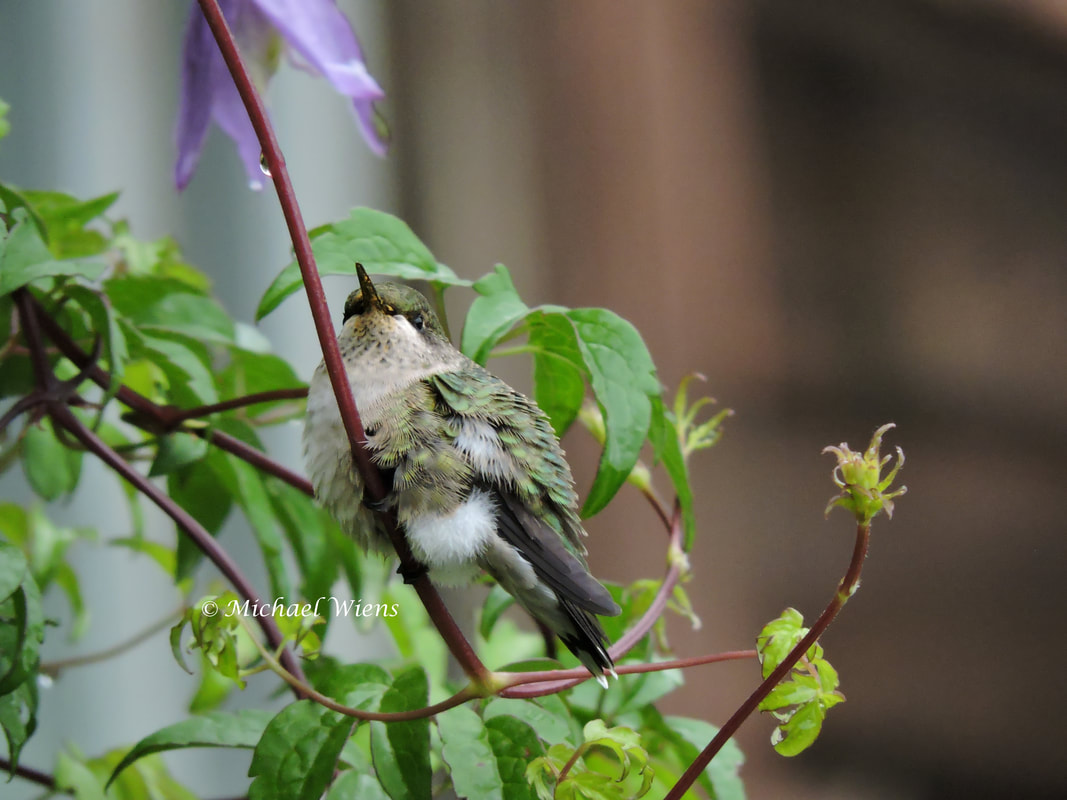 After every feeding session or fight with the rest of the hummingbirds, this young Ruby would make a returned visit back to this Bluebird Clematis. It was about 6 feet to the left of where I typically sat. I managed several decent photos of him, some perching and some feeding from the few late season blooms. He found enough value in these flowers to continue returning. In Spring-time, the newly arrived males also found value in this plant. It produced an abundance of flowers, almost to the point that the foliage was covered. This is the kind of target that attracts hummingbirds from long distances away, and contains enough flowers in Spring to keep a hummingbird's attention for a substantial amount of time. Clematises aren't typically high on the list for hummingbirds, but this particular one has proven effective. After seeing how well it attracted hummingbirds, I have taken cuttings and produced another dozen of them to spread out around the garden. This young male Ruby-throat wasn't yet into the grown-up food, but he certainly was a messy little eater in the flowers, which isn't uncommon for young hummingbirds. The image of the blooming Bluebird Clematis was taken in May. It is an early Spring bloomer with a smaller bloom later in the season. I like to have favorite hummingbird plants that bloom in succession throughout the hummingbird season. As one finishes, another will take over in the garden. The best times to have these big bloomers are during the month of their arrival from the South, and then again for the time the young leave the nest until the time they head back South. The stagnant nesting period is a bit less important as the adult female birds will typically use feeders to get their large dose of nectar within a short time and then get back to the nest quickly. During this time, the males will still scout out their options, not missing a single bloom that appears in their territory. N.E. of Edmonton, Alberta, Canada. Juvenile Male Ruby-throat hummingbird. August 2017 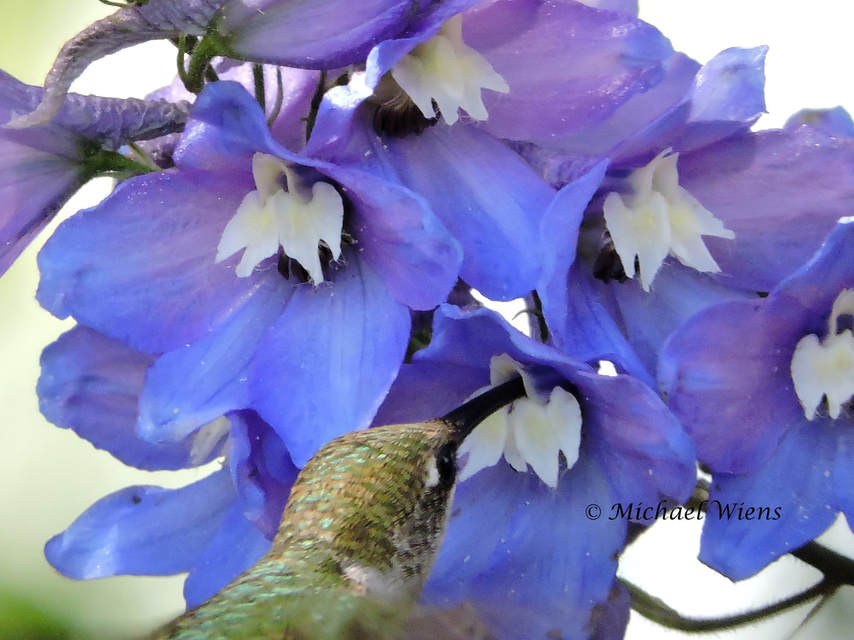 Every region has a flower that produces exceptional results when it comes to hummingbird sightings. When we first started creating our hummingbird garden we planted anything and everything. It looked fantastic, but the hummingbirds always reverted back to their favorites. The variety of colors and types of flowers were a huge attraction for any hummingbird that flew within half a mile of our place. It was any hummingbird's dream, until they showed up. Many flowers would be sampled, but they always chose their favorites, so 90 percent of the flowers would go untouched by them. It was after researching types of flowers and how many times they'd return to each type that I decided to cut down on the variety and go serious with the favorites. I'm down to about 8 annuals and perennials that I've gone heavy with. Other types remain in small numbers, but with the favorites, they get planted in masses around the yard. I've densely planted larger islands of flowers, all Delphiniums in several, Hostas in others and so on. They will go from island to island, and with the quantities in each, it keeps them busy for long periods of time without having to move around so frequently. With larger large quantities of their favorites, it makes it worth while for "non-feeder feeding juvies" to make the special trip to my garden. For the youngsters that don't yet know feeders, we have to make it worth while with large quantities of alternate food sources. Only one or two flower favorites forces them to expend more energy than what they gain from those few flowers. Speaking from a survival point, repeatedly flying to locations with few food choices would become fatal. Give them multiple reasons to return, and they will. Here is a closeup of a young Ruby-throat feeding from an all-time favorite in my region of the country. This is a Delphinium(Hardy zone 2 Perennial). N.E. of Edmonton, Alberta, Canada. August 2017 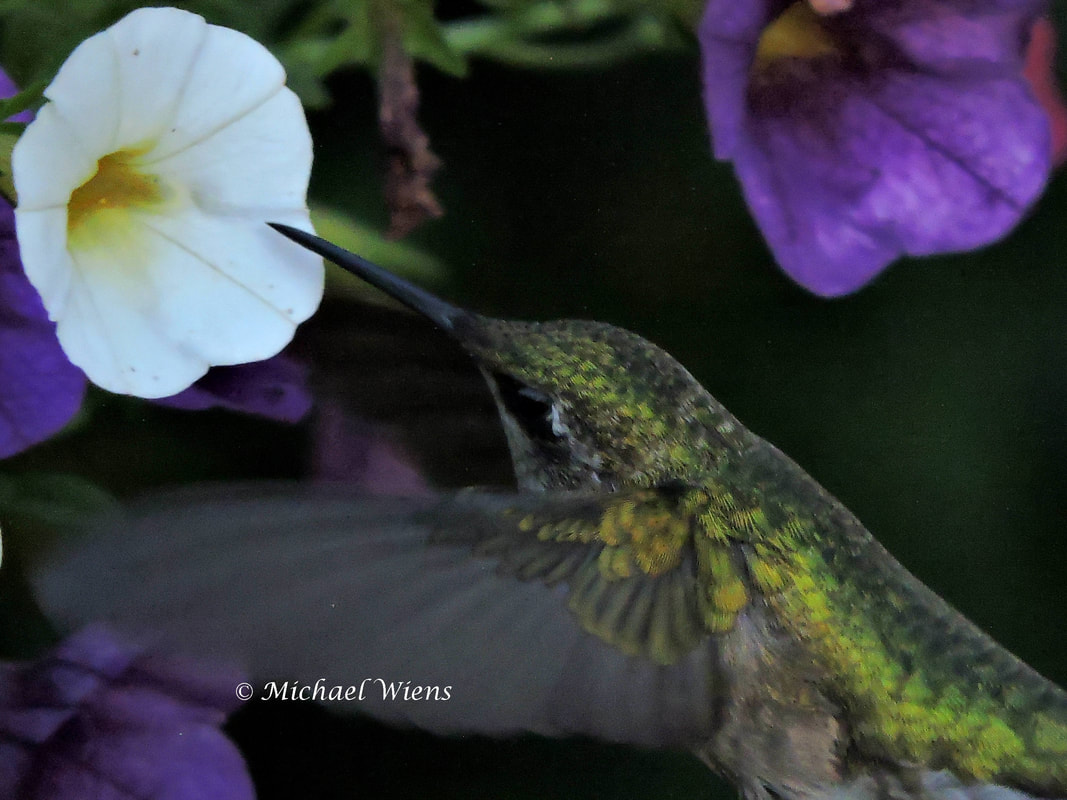 It was a cool crisp morning and the sun was still half an hour away from making an appearance. I sat on the deck prepared for some morning hummingbird entertainment. That 30 minutes before sunrise can be a very intense time for hummingbird feeding, especially after a very cool night without food. I glanced around the yard continuously, looking for sightings in the flowers and at the feeders. At a certain point I heard a faint humming. I started looking around me, up at the feeder that hung about 6 feet away, but nothing. The humming continued. "Where is it coming from"? I looked down at the camera on my lap, and right beside my chair was the clumsiest little juvenile Ruby-throat. He showed no concern for me, but fumbled around in the Million Bells while his uncoordinated little wings slapped around in the flower petals. He was impressed with what he found and gave me enough time to prepare the camera. The lighting was not so good that early in the morning, but I managed to snap a few pics before he carried on throughout the garden. It was because he had spent time there earlier that he continued to return throughout the day, and eventually blended in to all the other fighting hummingbirds. Juvenile Male Ruby-throat hummingbird. N.E. of Edmonton, Alberta, Canada. August 2017. |
Archives
June 2024
Categories
All
|
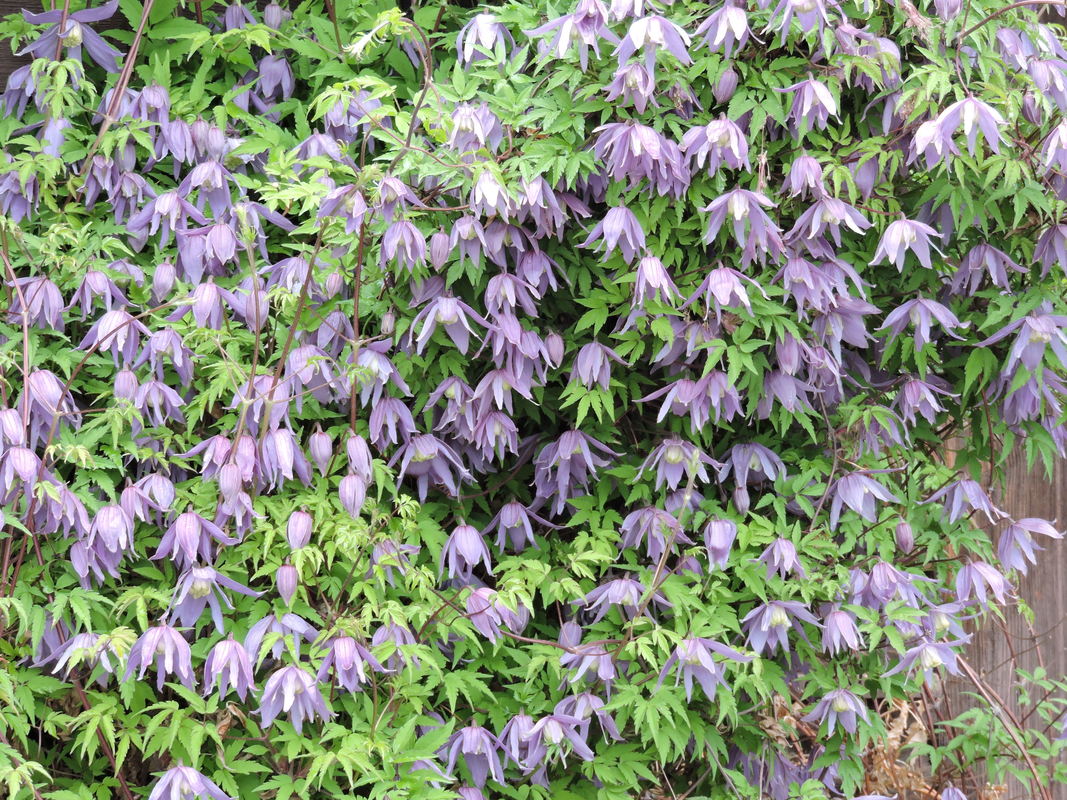
 RSS Feed
RSS Feed
